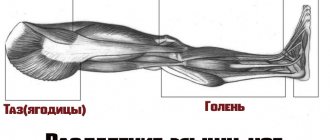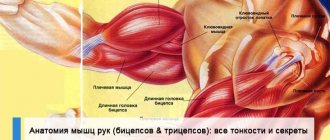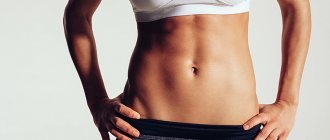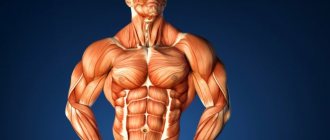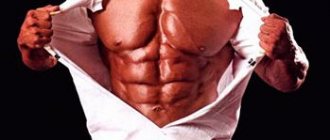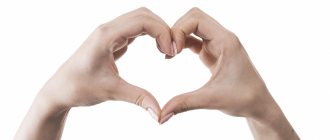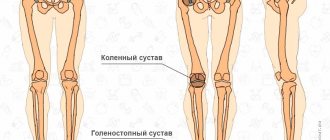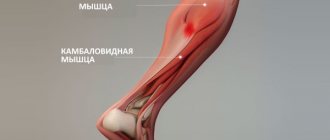Separation of the rectus abdominis muscles, or diastasis, is a common problem affecting mostly women. According to statistics, 70-100% of women develop this pathology in the third trimester of pregnancy. Normally, after childbirth, the structures should return to their original position, but in approximately 30% of cases this does not happen. A gap remains between the muscle tissues, which causes a bulging, flabby abdomen and provokes more serious consequences. That is why it is important to know how to determine diastasis of the abdominal muscles at home, which doctor can help, and what treatment methods modern medicine offers.
What is diastasis
To understand this concept, it is necessary to briefly outline the structural features of the abdominal muscles. In the center of the abdomen is the rectus muscle. It begins in the lower abdomen and extends to the pubic bone. Consists of two sections that are connected in the center by loose fabric. This connective tissue is called the linea alba.
As a result of prolonged and strong tension of muscle structures, intra-abdominal pressure increases. Weak tissues of the white line cannot withstand the load and begin to diverge. At the same time, the distance between the sections of the rectus muscle increases, they diverge to the sides and move several centimeters away from each other. A kind of furrow is formed, and when tense, the stomach protrudes unnaturally. Pathological discrepancy can form under the navel, above it, or have a mixed form.
The pathology should not be confused with a hernia of the white line or with an umbilical protrusion. It does not threaten to infringe on internal organs. But at the same time, even at an early stage it represents an aesthetic problem, since diastasis of the rectus abdominis muscle is much more often determined in women than in men.
Depending on the degree of discrepancy and the size of the formed distance, diastasis is divided into three degrees:
- first - the distance between sections is from 2.5 to 5 cm;
- second - the discrepancy reaches a gap of 5-8 cm;
- third - the size of the furrow between the sections exceeds 8 cm.
This classification allows you to understand how to determine the degree of muscle diastasis even at home.
Pathology can also affect other muscle structures of the anterior abdominal wall. Depending on what surrounding tissues are involved in the process, four types of diastasis are distinguished:
- A - classic form, in which only the rectus muscle diverges;
- B - loss of tone in the inferolateral muscle sections;
- C - appearance of expansion in the area of the xiphoid process, ribs;
- D - curvature of the waist line.
Service
Diaphragm and perineal muscles
The diaphragm separates the chest and abdominal cavities and is a thin muscle curved into a dome. The muscle bundles of the diaphragm begin from the upper lumbar vertebrae, lower ribs and sternum and converge to the tendon center, which forms the dome of the diaphragm. The diaphragm has openings for the esophagus, large vessels and nerves. During inhalation, the dome of the diaphragm flattens, causing the chest cavity to expand (which causes the lungs to expand), and the pressure in the abdominal cavity increases.
The perineal muscles form the floor of the pelvis and serve as support for the insides. The anterior part of the perineum is called the urogenital diaphragm, the posterior part is called the pelvic diaphragm. The muscles of the urogenital diaphragm in men surround the corpus spongiosum of the penis (and the urethra passing through it), and in women - the urethra and the opening of the vagina. The anus is located in the center of the pelvic diaphragm. Supporting the abdominal organs from below, the muscles of the perineum function simultaneously as sphincters (compressors) of the anus and urethra. To strengthen the pelvic floor, the muscles are arranged in several layers and woven into the tendon center of the perineum, which is formed by bundles of dense connective tissue and is located under the skin between the external genitalia and the anus.
Suturing of diastasis
Diastasis is a condition in which the distance between the rectus abdominis muscles increases. There are two methods of performing the operation - tension and non-tension. The rehabilitation period is relatively easy. At first there is swelling, hematomas, and pain. The first ones gradually go away on their own, and the pain is relieved with a drug prescribed by the doctor. Cost of the operation:
from 170,000 rubles Make an appointment with a doctor
More about the operation
WHAT DOES ALL OF THIS MEAN?
Let's remember the basic principle that guides us when working with certain muscles: their main function is to provide us with safe movement. Monitor changes in the distance of their attachment points. The primary function of muscles, from a functional point of view, is ECCENTRICAL CONTROL OF MOVEMENT AND ONLY THEN CONCENTRIC CONTRACTION, which we are all accustomed to in training. We look at the muscle and analyze which directions of movement will affect the change in its length.
SAGITTAL PLANE, during movements, flexion and extension of the body. Fiber elongation occurs to a small extent. The muscle will react to this to the same small extent.
FRONTAL PLANE – lateral tilts of the body to the right and left. Here we will see more variation in the spacing of the mounting points and more stabilization work. The muscle is activated more actively.
HORIZONTAL PLANE – rotations to the right and left. Given the way the fibers of the muscle are arranged, it is rotation that will have the greatest impact on the work of the transverse abdominis muscle in terms of movement in three planes.
INTERMEDIATE CONCLUSION: FOR THE TRANSVERSE MUSCLE TO FUNCTION NORMALLY, THE HUMAN BODY MUST HAVE MOVEMENTS BETWEEN THE PELVIS AND THE BODY IN ALL THREE PLANES.
Now let's look at the work of the muscle as a controller of intra-abdominal pressure and the most important stabilizer of the abdominal cavity. Here very serious demands are placed on the transverse muscle! It should provide stability to an area of our body where, apart from the spinal column, there are no rigid structures. And this stability is ensured due to the formation of a certain “hydraulic” cushion.
Causes of abdominal muscle diastasis
The main reason for the discrepancy is the excessively high pressure that occurs in the abdominal cavity. At the same time, the prerequisites for increased intra-abdominal fluid are of different nature. These include:
- Loss of muscle elasticity as a result of rapid weight loss.
- Excessive physical activity.
- Dysplasia is the abnormal development of tissues and organs. In addition to diastasis, it is accompanied by many additional manifestations: hernia, varicose veins, hemorrhoids, etc.
- Pregnancy. As a result of hormonal changes, collagen production is reduced, tissues lose elasticity and become loose. At the same time, the enlarged uterus significantly increases pressure on weakened muscle structures and the linea alba.
In 60% of cases, diastasis in women is associated with pregnancy. Pathology begins to develop in the middle of the second trimester. It is at this time that the muscles are stretched under the influence of increasing abdominal pressure. Normally, after childbirth, the uterus restores its previous size, and the width of the white line returns to its normal value of up to 2 cm.
However, in many cases, the recovery process is complicated by concomitant factors that prevent the tissues from returning to their previous position. These factors include:
- mature age of the woman in labor;
- excess weight before and during pregnancy;
- the fruit is too large;
- number of previous pregnancies and births;
- type of pregnancy (one fetus or several);
- complications during pregnancy;
- too rapid return to active physical activity after childbirth.
Diastasis can also occur in children, especially premature babies. The key prerequisite for the development of pathology is the failure of the child’s muscles and tendons. In this case, most often the defect is eliminated on its own during the first year of the baby’s life. During this period of time, the muscles acquire tone, the ligaments become strong. Only children with Down syndrome are at risk of maintaining the discrepancy.
In only 1.5% of cases, diastasis is diagnosed in men. The basic prerequisites are the same as for women: obesity, dysplasia, sudden weight loss. Also, men are more likely to be overly involved in strength training, which not only causes hernias and varicose veins, but also provokes the formation of diastasis.
Basic abdominal exercises
Now that we have studied the structure of the skeletal skeleton and muscles, and also understood the biomechanical processes of the core muscles, it’s time to apply all this knowledge experimentally. Here are a few basic exercises that require no special training and will allow you to get the most out of it.
Exercise #1 – TRX loops
The TRX is a very effective machine that can give you rock-hard 6-pack abs and improve your balance. Many people have completely untrained lower backs, as this is a rather difficult place to work the muscles. Therefore, they need additional measures to compensate for the tension and create the best balance of the anterior and posterior muscle groups.
Starting position – stand up straight, fasten the loops on your hands. Exhale, tense your body muscles.
Then bring your arms together vigorously in front of you. Watch your back - it must be straight!
This exercise works the rectus abdominis, internal and external abdominal muscles. The spine, neck and upper back are actively trained. You can control the strength and intensity of the movements yourself, which is very convenient.
Exercise No. 2 – dead beetle
The exercise perfectly works the abdominal muscles without putting unnecessary stress on the lower back.
Lie on your back, raise your arms up. Then lift your leg at a 90-degree angle and, at the same time, lift your opposite arm. Hold the top position for a bit and return to the starting position. Please note: your back should be pressed tightly to the floor, no need to rise. Try to touch your heel, stretch the muscles.
Exercise No. 3 – Pallof press
This is a great exercise to strengthen your oblique abdominal muscles. Allows you to control the rotation of the body to the sides.
To perform this you will need an expander with a handle for your hands. The challenge is to do a forward press with a pulley at your side. Take the handle in your hands and begin to pull forcefully towards yourself. This is not easy, the force of resistance will actively hinder you. The quadratus lumborum muscle, transverse, internal and external oblique abdominal muscles are well worked out. Hold the handle against your chest for 20-30 seconds, then return to the starting position.
Exercise #4 – One Arm Deadlift
The one-arm deadlift is a very useful exercise for improving balance. Take one dumbbell and stand straight. Bend forward, holding a dumbbell in one hand and squeezing your abs. Then return to the starting position. Gradually make the exercise more difficult by bending down as low as possible.
Since the weight is on one side, you will have to make every effort to maintain balance. This exercise is also great for increasing your strength and developing endurance. The oblique muscles and quadratus lumborum muscles are involved.
Signs of abdominal muscle diastasis
For a long time, the pathology has an asymptomatic course. Manifestations increase as the discrepancy develops and complications appear. And if in women the signs of diastasis of the rectus abdominis muscles are maximally manifested after pregnancy and childbirth, then in men - only when the pathology is already in an advanced state.
The main and most noticeable manifestation of the pathology is a rounded vertical protrusion of the abdomen. If you deliberately tense your abdominal muscles, a groove between the right and left halves of the body becomes visible. At the same time, in men, even with intense strength training, the abs are not sufficiently worked out and do not acquire the desired relief.
If the disease progresses, the pathological structure of muscle tissue and disturbances in muscle function become the cause of other, more dangerous characteristic manifestations. There are:
- pain in the spine, lower back;
- posture disorders;
- increased fatigue;
- dysfunction of the gastrointestinal tract, which is accompanied by heartburn, belching, pain, constipation, flatulence.
At the third stage of the pathology, dangerous complications are possible, which manifest themselves in the form of:
- ptosis, prolapse of internal organs;
- intestinal obstruction;
- urinary incontinence;
- renal colic;
- feeling of heaviness in the legs while walking;
- muscle atrophy in the abdominal area.
Press service
Ana Forrest (author of Forrest Yoga) began practicing yoga with twenty years of dance experience behind her. “In our first lesson, the Iyengar yoga teacher told us to relax our stomachs,” Forrest recalls. “The instructions seemed very strange to me, because from my choreographer I always heard the opposite: the abdominal muscles should be retracted and well pumped. To my surprise, relaxing the abs was not at all easy. However, I found freedom in practice only after I learned to release the tension in my abdominal muscles and include them in the breathing process.”
Soon Forrest began practicing yoga under the guidance of other teachers. “Each teacher had his own approach to working the abdominal muscles,” she says. – Some people demanded to “pull the base of the abdomen up and make it hollow,” others – “raise the sides of the waist and direct the stomach towards the spine.” In one Uddiyana Bandha (abdominal lock) class, we were taught to “pull the abdominal muscles above and below the navel inward towards the spine.” In the end, after yet another teacher told her to “pull your belly up from the very center, but not create rigidity,” Ana realized that she was confused by conflicting recommendations. She asked herself, “So what are strong, healthy abdominal muscles? What is the difference between fitness and yoga? And what is hidden behind all these mysterious instructions?
“There are actually a lot of misconceptions about how the abdominal muscles work in asanas,” says Gene Couch, author of The Runner's Yoga Book. This is understandable, because in modern society thinness and a flat stomach are the standards of beauty and health. But in fact, for most people, the stomach is in constant tension. But it is impossible to strengthen rigid abdominal muscles. Correct work in asanas can be achieved only if the muscles are relaxed.”
According to Couch, only elastic and elastic abdominal muscles ensure the proper functioning of the abdominal organs. “I don’t tell students to pull their belly in,” Jean continues. – While in the asana, simply lengthen your spine, and then the abdominal muscles will retract naturally. In this state, the stomach will remain soft, necessary for deep breathing in the pose. In addition, the muscles will remain elastic, which will stabilize the body position in asanas, in particular in balances on one leg, such as Vrikshasana (Tree Pose).”
Most yoga teachers agree that strong, healthy abdominal muscles are essential for a complete practice. But there is no consensus on how to strengthen them. Moreover, supporters of a holistic approach to working with the body generally consider it incorrect to detail the practice of yoga and refuse to explain incomprehensible points in working with the abdominal muscles. What's the matter?
A look from the inside
“Many problems associated with the functioning of the abdominal organs often indicate people’s inability to cope with their emotions,” says Ana Forrest. And working with the abdominal muscles, in her opinion, “frees you from physical and emotional stagnation.” Perhaps unexpressed emotions “accumulated” in the abdominal area are the reason why some teachers diligently avoid conversations on this topic? “We hold a huge psychological ballast in our bellies,” says Joan White, chair of the Iyengar Yoga Teacher Certification Board in the USA. “This is where our anxiety hides.” When a person experiences anxiety, his stomach is compressed and any excess tension in this area is unsafe for health.” However, unlike yogis, physiologists and fitness trainers are not at all tormented by doubts about ways to strengthen the abdominal muscles. “Today's trend is to show off a toned, flat stomach, and abdominal exercises are more in demand than ever,” says exercise physiologist Tom Seaburn, co-author of Athletic Abs.
Belly in detail
As a rule, fitness fans strengthen the rectus abdominis muscle - those same “cubes” - which stretches from the pubic bone to the sternum. “This muscle bends the torso forward, thanks to it we get out of bed in the morning,” explains Seaburn. “The rectus abdominis muscle is the most superficial of the four that make up the abdominal group.” The internal and external oblique muscles, located on both sides of the torso, provide lateral rotation. The transverse abdominal muscle lies the deepest. It is located in the horizontal plane under the rectus and oblique muscles. This is one of the few muscles whose fibers are located transversely.
“Yoga is ideal for training the abdominal muscles because it develops flexibility and strength in different directions,” says Seaburn. – Many people mistakenly believe that abdominal muscles can simply be pumped up with the help of fitness exercises. However, the range of motion in these exercises is too limited: the body only moves in one direction, which significantly shortens the muscles.”
Pilates and Rolfing (deep massage techniques) are alternative methods of working with the body to fitness. In Pilates, for example, there is a special breathing technique that helps strengthen the abs. “In all Pilates exercises, we inhale through the nose and exhale only through the mouth,” says Pilates instructor Moira Merithew. “This type of exhalation creates resistance in the abdomen, thanks to which a person can better feel the contraction of the abdominal muscles and fully concentrate on them.”
Certified Rolfing teacher Michael Feldman encourages his students to develop abdominal sensitivity using their hands. “When you start working with the abdominal muscles, first feel the ilia, direct them towards each other, while lengthening the back and making the stomach “empty.” And you will immediately feel the transverse abdominal muscles,” Feldman is sure. In his opinion, weakness of the abdominal muscles is often explained by the fact that we slouch when sitting: “To maintain the elasticity of the muscles, it is important to learn to sit on the sit bones and with a straight back.”
Inhale-exhale
Synchronizing your movements with your breathing during a yoga practice is another way to strengthen your abdominal muscles. Viniyoga teacher Kathleen Miller says the area between your pubic area and belly button is the hardest area to become aware of. Miller's students awaken the "sleeping zone" with a special exercise. “Lying on the floor, bend your knees and place your feet on the floor. Place one hand on your stomach just above your pubic area. Breathe evenly and contract the abdominal muscles under your arm with each exhalation. Try to feel how your navel moves towards your spine, your lower back lengthens, and your pelvis becomes more compact.”
What Kathleen is talking about is directly related to the practice of uddiyana bandha. Technically, uddiyana bandha is a subtle contraction of the abdominal muscles that is not easy to feel. In order to feel the area where the abdominal lock occurs, Ashtanga yoga teacher Tim Miller suggests exhaling completely and remaining for a moment in the state of emptiness. “At the end of the exhalation we should naturally feel this ‘energy’ zone from within,” he says.
According to the founder of shadow yoga Sandor Remete, one of the effective methods of strengthening the abdominal muscles is the regular performance of the Surya Namaskar (Sun Salutation) complex: in Uttanasana (Forward Bend from a standing position), the muscles contract, and in Urdhva Mukha Svanasana (Upward-Facing Dog Pose) they stretch . In addition, Sandor recommends Hanumanasana (Monkey King pose), Mayurasana (Peacock pose), which develops strength while making the muscles elastic, Paripurna Navasana (Boat pose) and Nauli (wave-like movement of the abdominal muscles and abdominal organs). At the same time, Sandor reminds that yoga is not a sport, but a system of working with energy, and strong muscles are not the goal of practice. Moreover, an overinflated and hard press can block the movement of energy and thus reduce the vitality of the body.
Be sure!
Due to the fact that modern man spends most of his time in a sitting position, the abdominal muscles become weak over time, and their work is taken over by the back muscles - both in everyday life and in the practice of asanas. “If your abdominal muscles are not strong enough, then, for example, lifting your legs at a 90-degree angle from a lying position will strain your lower back muscles. And this is fraught with injuries to the lower back,” notes White. Weak abdominal muscles and lower back pain are common problems, and to avoid them, Forrest recommends doing abdominal strengthening exercises daily. “Whatever pose we perform, the central muscles of the torso must be strong,” she emphasizes. – This is especially true for hand balances, where we resist the force of gravity. Eka Pada Bakasana (Single Leg Crane Pose), Tittibhasana (Firefly Pose) and Ashtavakrasana (Ashtavakra Pose), as well as variations of Adho Mukha Vrikshasana (Handstands) all require core strength to practice. In addition, strong and aware abdominal muscles give a feeling of self-confidence in everyday life.”
Forrest herself spends at least fifteen minutes working on her abdominal muscles in her classes. It was thanks to strengthening the abdominal area that she was able to recover from a back injury. “At first, many people hate abdominal exercises because they are hard and even painful. But after some time you realize the need for this work. Listen to your body, trust it. If, as you suck in your stomach, you feel your posture has improved, and you have become more cheerful and confident, then you are on the right track. If tension arises, this is a reason to think. In yoga, you can make decisions based on your inner feelings that the practice gives. You just need to learn to trust yourself. Explore yourself to understand what is best for you,” Forrest advises students.
Elbow to kneeLying on your back, bend your knees and lift your feet off the floor - thighs perpendicular to the floor. Stretch your feet through the balls of your big toes and spread your toes out to the sides. Interlace your fingers at the back of your head and relax your neck. As you inhale, raising your head and rounding your back, stretch towards your legs. Holding your breath, point your tailbone toward the ceiling. As you exhale, bring your left elbow toward your right knee, keeping your right thigh perpendicular to the floor while straightening your left leg. At the end of the exhalation, point your tailbone towards the ceiling even more actively and draw in your stomach. As you inhale, return to the starting position. Repeat 5-10 times in each direction. |
"Frog"Stretch your legs perpendicular to the floor, then spread them apart and bend your knees. At the same time, the feet are active. Lengthen your hips outward from your pelvis. Interlace your fingers behind your head. As you inhale, round your back and lift yourself off the floor. As you exhale, point your tailbone toward the ceiling. At the end of the exhalation, draw your stomach deeply inward. Without lowering your head and upper back, inhale and press your lower back and pelvis into the floor. As you exhale, point your tailbone upward more actively, and as you inhale, round your back more. Repeat 5-10 times. If you have rather weak muscles in the lower back, abdomen or inner thighs, perform this exercise with your soles pressed against the wall. |
Wide Leg RaiseLying on your back, clasp your hands behind your head. Lift your legs up and then spread them wide to the sides. Don't let your hips move towards your shoulders, otherwise most of the stress will be on your legs rather than your abs. Stretch your legs, pointing your toes away from you. As you inhale, lift your head and upper back off the floor, supporting your head with your hands. As you exhale, point your tailbone toward the ceiling. At the end of the exhalation, draw in your stomach. As you inhale, lower your body and pelvis to the floor. Repeat 5-10 times. If you have weak lower back muscles, perform the exercise with the backs of your legs pressed against the wall. |
twisted rootLie on your back. Bend your knees and place your feet on the floor. Place your right thigh under your left. If possible, place your left ankle under your right shin as in Garudasana (Eagle Pose). Interlace your fingers at the back of your head and bring your hips perpendicular to the floor. As you inhale, lift your head and upper back off the floor. As you exhale, point your tailbone toward the ceiling and lift your pelvis. At the same time, pull your stomach in. Inhale and lower your pelvis to the floor, keeping your head and neck suspended. If you don't feel the work in your lower abdomen, gradually move your hips away from you, but only until your lower back presses into the floor. |
Exercise matFold the mat in half and then roll it into a roll about 15-20 cm in diameter. Lie on your back and place the mat between your thighs. Interlace your fingers at the back of your head and extend your legs up toward the ceiling. Inhale and hold your breath, pointing your tailbone toward the ceiling. Then squeeze the mat tightly with your thighs and extend your legs even more actively, pointing the inner edges of your feet towards the ceiling. Keep your legs upright and don't let them drop towards your head. As you exhale, draw in your stomach, press your lower back and lower ribs to the floor. At the same time, raise your head and chest even higher. As you inhale, lower your head, upper back, and pelvis to the floor. This is a difficult exercise. At first, do it 3-5 times, but no more. |
Agni Sara Dhauti (Purification by Fire)Stand up straight and place your feet a meter apart. Bend your knees and place your hands on your hips. Keep your back straight using the strength of your arms. Lower your chin into the interclavicular cavity. Take a deep breath in through your nose and then exhale forcefully through your mouth, pushing all the air out of your lungs. Hold your breath and draw your stomach inward towards your spine, performing uddiyana bandha (abdominal lock). Then relax your stomach completely. Continue alternately drawing in and relaxing your stomach until you feel the need to inhale. As you inhale, relax your stomach very slowly so that your inhalation is soft. Perform one cycle, making movements slowly, the second - quickly drawing in and relaxing the stomach. As you master the practice, perform both variations three times in a row. |
Nauli (Wave-like movement of the abdominal muscles)Stand straight with your feet about 30-60 cm wide. Bend your knees and place your palms on your thighs. Take a deep breath and then exhale forcefully through your mouth, completely emptying your lungs. Draw the sides of your abdomen inward so that your abdominal muscles form a firm, convex “bar.” Then point your pelvis to the left and draw in your abdominal muscles, pointing them to the left. Point your pelvis to the right and pull your abdominal muscles to the right. Rotate your pelvis and abdominal muscles clockwise until you feel the urge to inhale. Repeat the exercise, this time making movements counterclockwise. Do the whole complex 5 times. At first, you will only have barely noticeable indentations on both sides of the abdominal cavity. Practice nauli in front of a mirror to see what is happening to your stomach. |
How does a doctor determine the presence of diastasis of the rectus abdominis muscle?
If any of the listed symptoms appear, as well as if there are predisposing factors such as recent pregnancy and childbirth or increased physical activity, you should consult a doctor for examination. You can’t delay your visit; it’s better to see a specialist for prevention than to wait until dangerous complications appear.
Many people do not know which doctor determines the presence of diastasis of the rectus abdominis muscles. You need to contact a surgeon. In most cases, an experienced specialist will be able to determine the pathology using only palpation examination.
For diagnosis, the patient lies on his back, slightly bends his knees and rests his feet on the surface. After this, the surgeon asks you to tighten your abdominal muscles. At the same time, you need to raise your shoulder blades and head. The doctor feels the abdomen, measures the width of the discrepancy, and determines the presence and stage of the pathology. In this case, pronounced diastasis of the third degree is noticeable even in a standing position.
In some cases, the study of the width of the white line is complicated by excess body weight. The doctor refers such patients for an ultrasound examination. This procedure is also prescribed if there is a suspicion of the development of complications: hernial protrusions, displacement of internal organs. In rare cases, radiography or computed tomography is necessary.
Diagnostics
Differential diagnosis of diseases caused by trigger points in the abdominal muscle wall should take into account diseases such as:
- joint diseases,
- fibromyalgia,
- appendicitis,
- stomach ulcer,
- cholelithiasis with colic,
- colitis,
- diseases of the urinary system,
- menstrual irregularities,
- chronic pain in the pelvic cavity
- and other diseases.
When examining a patient, it is very important to pay serious attention to the patient’s posture when walking, standing and sitting.
Anamnestic data can help identify the cause of complaints of pain. The doctor draws up an accurate pain distribution diagram based on the patient’s words.
Myofascial trigger points of the rectus abdominis muscle depress its supporting function. If they are present in the rectus abdominis muscle, the patient's stomach sag when standing. A tight cord is felt throughout the abdomen, which is associated with an active trigger point, shortening only one segment of the muscle between the transverse tendon bridges in which it is located.
An active myofascial trigger point inhibits the contraction of adjacent segments of the rectus abdominis muscle. Contraction would help relieve tension in the affected muscle fibers, lengthening, rather than shortening the entire muscle as a whole. When taking deep breaths, the patient exhibits paradoxical breathing. While during quiet breathing exhalation is carried out due to the elasticity of the lungs and less assistance from the muscles is required, patients will subconsciously restrain the normal contraction of the diaphragm during inhalation, due to fear of pain when stretching the rectus abdominis muscle. This is a reflex inhibition of the muscles - the diaphragm and rectus abdominis.
And at the moment when the patient takes a deep breath with the participation of the diaphragm and thereby causes a protrusion of the abdomen, the pain reflected from the trigger points sharply worsens.
If there are trigger points in the rectus abdominis muscle, referred pain may be distributed along both sides of the spine, across the lower back. With deep breathing, the pain always intensifies, in particular when the back is straightened in the presence of pronounced lumbar lordosis, which subsequently causes stretching of the rectus abdominis muscle. Back pain caused by trigger points of the paravertebral muscles does not always affect the act of breathing. A hernial formation in the abdominal cavity is detected with the patient standing.
How to determine the presence of abdominal muscle diastasis yourself
Diastasis can be determined at home. A simple test will help you do this, during which you need to measure the distance between the edges of the rectus muscle.
To do this, you need to lie on your back on a hard surface, bend your knees. Place one hand under your head and the other on the white line, just above your navel. Then you should relax and raise your chest. In this case, you need to feel the discrepancy between the muscles with your fingertips. The gap is most pronounced between the navel and the xiphoid process. If the discrepancy is greater than the width of two fingers, this should alert you and be a reason to contact a specialist.
This technique is as similar as possible to the approach that a surgeon uses for diagnosis. This is the easiest way to determine diastasis at home without the help of a doctor and instrumental examinations.
Abs secrets
♦ The abdominal muscles are classified as endurance muscles, so they cannot be created by doing 8 repetitions like the arms, chest or back; to tire them out, you need to perform a large number of repetitions, do at least 25-40 times, with a feeling of the muscle and strict adherence to technique .
♦ If you want clearly defined muscles, while maintaining a narrow waist, forget about exercising with additional weights (dumbbells in your hands, weights on your legs or a weight on your neck), so you, of course, will build abdominal muscles and you will have cubes, but your waist will increase in volume. Do a lot of reps with your own weight, the build period may be longer, but the results will be worth it.
♦ Follow a diet, otherwise all the fruits of your labor will be hidden under fat deposits, consume more vitamins and minerals, plenty of proteins, moderate carbohydrates and minimize fat intake.
♦ If at the end of the exercise you feel a burning sensation in your abs, as if something was squeezing your stomach, then everything was done correctly, your back hurts - replace the exercise, you don’t feel the muscle - you are violating the technique or not finishing it to the end.
♦ It’s better to do fewer repetitions and better quality than a lot, but whatever.
Beautiful abs are not a myth, but a reality, take care of yourself and you yourself will be surprised by the effect achieved.
How to remove diastasis
The treatment regimen for the pathology depends on the stage of its development and the degree of manifestation. At the first stage, it is enough to follow the doctor’s recommendations, which will help strengthen the muscles of the abdominal wall and reduce their discrepancy:
- reduce weight to normal levels;
- maintain a balanced diet with limited consumption of fatty and sweet foods;
- adhere to the daily fluid intake;
- wear a bandage that supports the stomach;
- undergo massage and other physical procedures;
- do swimming, yoga, Pilates or physical therapy.
Physical therapy should be carried out under the supervision of a specialist. He creates a program with the correct load level. Particular attention is paid to the deep transverse and oblique abdominal muscles, which, with an appropriate level of tone, reduce the degree of stretching of the linea alba.
A set of therapeutic exercises is useful even for pregnant women. With its help, you can prevent the development of pathology and speed up the process of postpartum recovery of the body.
Such training takes place without straining the abdominal muscles. It is also not recommended to do exercises while standing, including on your knees or elbows. Such loads are permissible only after restoration of the normal width of the lumen.
In later stages, the discrepancy can no longer be corrected with exercise or massage. Surgical intervention is necessary to return the muscle corset to its place and relieve complications and symptoms. It could be:
- Tensionplasty using patient tissue. The surgeon removes excess connective tissue and stitches the edges of the muscles together. This method is the least preferable, since relapses occur quite often after it.
- Tension plastic using a prosthesis. It involves the same removal of excess tissue and suturing of muscle layers, but is accompanied by additional strengthening using a mesh polypropylene prosthesis.
- Tension-free plastic surgery with installation of a prosthesis. An endoprosthesis is inserted under the stretched area, which serves as a barrier and replaces the weakened structures.
- Combined approach. It involves a combination of tension and non-tension plastic surgery.
The specialist selects the surgical method taking into account the characteristics and degree of development of the pathology, as well as individual factors and the patient’s health status. Full recovery after the intervention occurs within 1 to 3 months. At this time, it is necessary to avoid excess tension, adhere to a diet and wear a special bandage that relieves stress from the operated muscle structures.
Functions of the abdominal muscles
Below are the functions performed by the core muscles. Some of them are probably already familiar to you: squats, body bends. It turns out that the task of muscles is not only to flex and extend parts of the body. Here are the main five functions of the abdominal muscles:
Intrathoracic pressure
Take a deep breath and hold your breath. In this case, the diaphragm begins to put pressure on the pelvic floor and the transverse abdominal muscles. It is this process that is so important for maintaining the strength of the spine, and also allows us to perform exercises such as squats, deadlifts and various presses.
Anti-extension
Most people, especially those who have just begun their acquaintance with fitness, believe that the abdominal muscles, like the spine and back, are given to us only for bending the torso. Now try leaning back? Does not work? This is because our spine is securely secured by the rectus abdominis and oblique (external and internal) muscles to prevent sagging and curvature.
Lateral flexion and anti-lateral flexion
The internal and external oblique muscles help us bend in different directions. This is lateral bending. In addition, it is the oblique muscles, as well as the quadratus lumborum muscle, that perform the function of anti-lateral flexion. This is necessary to maintain the spine in a neutral position and maintain balance. Imagine you are carrying a heavy bag. One side of the body takes on the entire load and makes further movement possible, while the other has to maintain balance so that you do not fall on your side.
Anti-rotate
The rectus abdominis, transverse and oblique (external and internal) muscles are responsible for turning the body to the sides. They not only help rotate the body, but also prevent uncontrolled movements and keep the torso in a straight position. This muscle function is very important, especially when lifting weights with one arm.
Anti-bending
Abdominal exercises are a prime example of flexion. We can all bend forward – it’s natural. But if you're doing barbell squats or deadlifts, it can be difficult to keep your balance without falling on your face. Thanks to the abdominal muscles, our torso is able to maintain position without loading the spine.
Prevention of diastasis
To reduce the risk of developing pathology, it is extremely important to systematically follow preventive recommendations. To do this you need:
- adhere to a proper balanced diet;
- lead an active lifestyle, walk more;
- strengthen all muscle groups, especially the muscle structures of the abdomen and lumbar region;
- eliminate excessive physical activity;
- do not lift weights, especially for women;
- strengthen the diaphragm;
- monitor your weight and prevent obesity.
During pregnancy, you need to use special oils, creams, ointments that increase the elasticity and firmness of tissues. After childbirth, it is necessary to carefully monitor the condition of the press in order to detect pathology in a timely manner and, if necessary, seek help from a doctor before complications develop. Treatment of the initial stages of discrepancy is successful and does not require excessive effort from the patient.
Skeletal structure in the abdominal area
Often we don't even think about the importance of bones in our body, focusing all our attention on the muscles. But bones and cartilaginous joints are of great importance for the development of muscle tissue.
Pelvis
The pelvis has two main movements: a forward tilt, in which the hips move back, and a posterior tilt.
Lumbar
The lumbar spine consists of five vertebrae located between the rib cage and pelvis. It affects the lumbar curve (movement forward, backward, lateral bending, rotation of the torso).
You can feel how important all these movements are during training: the resistance force holds the spine in place and prevents the vertebrae from bending. The lumbar region is not particularly flexible except for forward and backward bending, so the more you can control or resist the movement, the healthier and stronger your back will be. And this is the first and, perhaps, main condition for strength exercises.
